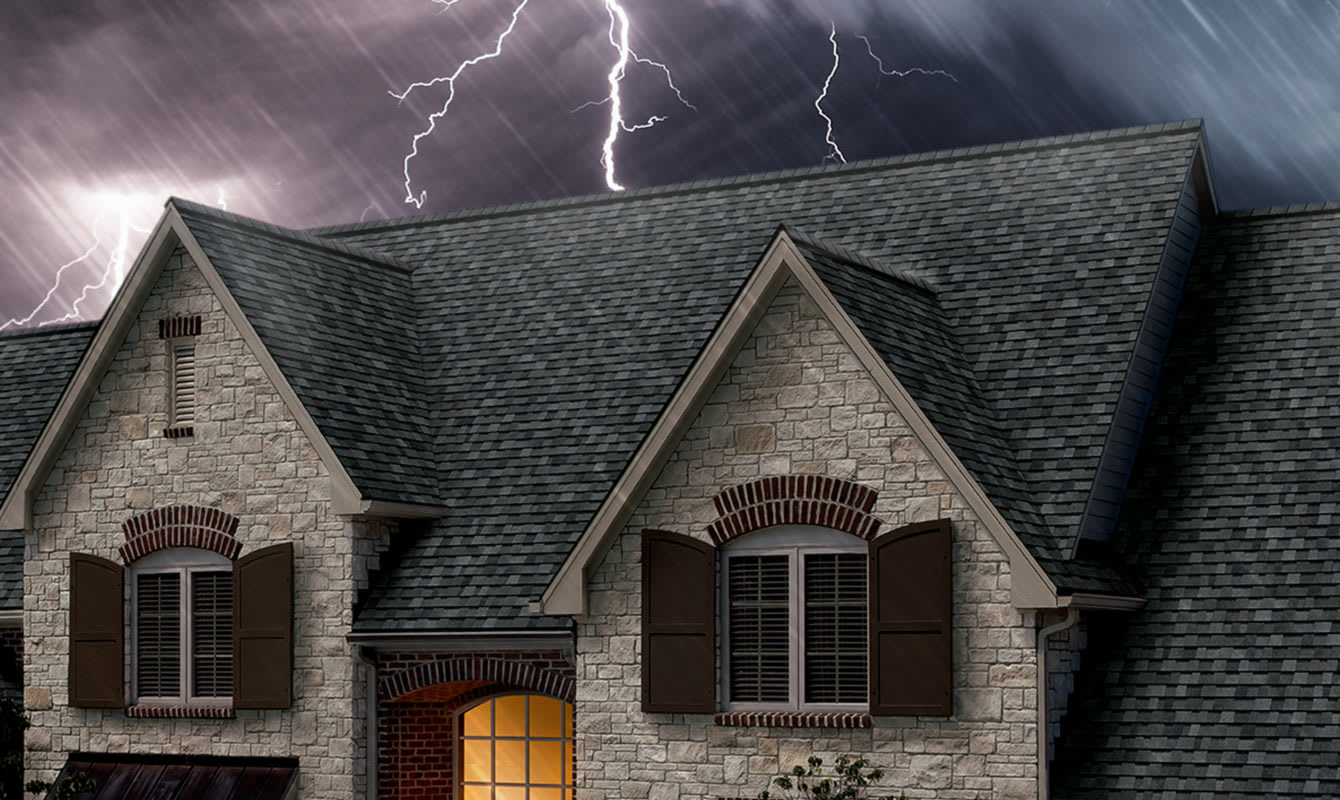Roof Smarter™Got questions?
Got questions?
Check out our expert resources to help you get started.


No matter where you live in the United States, chances are you’ve encountered your share of rough weather over the years. From tornadoes, hurricanes, hailstorms, and summer squalls that bring driving wind and rain, storms can wreak havoc on roofs and other exterior home surfaces.
How do you identify roof damage, and what should you do about your roof after a major storm?
Browse this resource guide on understanding types of roof storm damage and learn what steps you should take, then download the Owens Corning roof storm damage checklist for future reference.
(And to learn more about all that goes into a roofing project, visit our Roof Smarter page.)
Hurricane-force winds, which are classified by meteorologists as 74 mph or greater, or gale-force winds, which are between 39-54 mph, can cause visible damage to your home’s roof. High winds can remove or tear shingles, leaving the underlayment, roof deck, or waterproofing material exposed to the elements.
During less severe storms, sudden, sharp gusts of wind can lift and curl shingles. When shingles are installed, they’re purposefully overlapped to create a water-tight seal, and this lifting and curling can break this seal, potentially leaving your roof vulnerable to damage from wind-driven rain.
While hailstorms tend to be relatively short, and rarely last for longer than 15 minutes, hailstones can leave dents or pockmarks in shingles and knock shingle granules loose. This can be problematic because these granules help protect your roof against rain and sun damage. Hail damage can also ruin the pleasing aesthetic appearance of your roof’s surface.
Roofs without proper drainage can experience problems with standing water after big rainstorms, especially in uneven areas. Clogged gutters can also cause backed up rainwater under your shingles, which allows moisture to potentially penetrate the underlayment or the roof deck.
Depending on how severe the storm was, debris can end up on the top of your roof, everything from small branches to larger tree limbs. Large objects can dent or impact the surface of the shingle, leaving that area of the roof vulnerable to moisture intrusion, whereas lighter branches may not be as much of a problem.
Refer to this roof storm damage checklist to help you better understand the type of damage your roof may have sustained and to evaluate whether you need an entirely new roof or just parts of it repaired or replaced.
As always, safety is first. Contact a trusted, professional roofing contractor to schedule an inspection and help you with damage assessment. Many contractors offer free inspections and will know how to safely look for roof damage.
Roof: Visually assess your roof by walking around the perimeter of your house and taking note of any visible storm damage.
You might also have a good view of parts of your roof from one of your windows. Keep a list of notes and/or take pictures — this can potentially be helpful later for insurance purposes. Any visible signs of storm damage should be documented, such as dented, torn, curled, or missing shingles.
Gutters, Vents, and Windows: Check for dents on your home’s gutters and roofing accessories, such as gable vents and other overhangs. Windows should be inspected for cracks, broken glass, loose weather-stripping, and torn screens.
Outside Areas: Walk around your home’s exterior and look for fallen tree limbs, missing fence posts, or damage to lawn furniture and other decorations. Flat surfaces, such as patios and decks, can be checked for hail damage.
Attic and Ceilings: Observe these areas for leaks and water spots. While your home’s roof might appear undamaged on the exterior, wind and hail can cause unseen leaks that may lead to bigger problems later. Ceilings, light fixtures, and your attic should all be inspected for water leaks and spots. Use a flashlight to see in dark areas.
It’s important to work with a contractor you can trust. Roofers and repair companies are likely to be busy after a large regional storm and may try to compete for your business by offering discounts or deals. If it sounds too good to be true, it probably is.
A good place to start your research is with independent roofing contractors with Preferred or Platinum Preferred membership levels in the Owens Corning Roofing Contractor Network.
Roofing contractors can:
It’s important to know what to ask and what to look for when talking to and choosing a reliable roofing contractor. Here are some tips to help you:
If you find significant damage to your home after a storm, it’s essential to involve your homeowners insurance provider right away so you can properly file a claim based on their requirements.
Its representatives can help you file a claim and get adequate compensation based on the notes and photographs you collected from your storm damage assessment. The company may also send its own assessor or inspector to your home to thoroughly evaluate the roof storm damage your home sustained.
If your home has sustained roof storm damage, download the Owens Corning roof storm damage checklist to help you figure out your next steps. Then, find an independent roofing contractor in the Owens Corning Contractor Network (OCCN) near you.
Got questions?
Check out our expert resources to help you get started.
Next Steps

Getting the color and shape of shingle you always wanted is a great way to express your individual personality and add real value.

Purchasing a new roof is one of the biggest decisions you’ll ever make for your home, so it’s important that it’s done right and that you have someone standing behind the work for years to come.

Build Your Roof™ empowers you to select each layer and component that goes into your Total Protection Roofing System®+ so that you get the roof you want to protect your home.